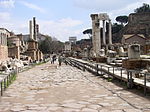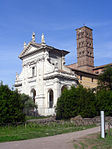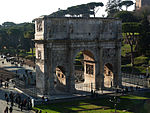Temple of Venus and Roma
1352nd-century religious buildings and structuresHadrianHadrianic building projectsRome R. X Campitelli ... and 2 more
Temples of VenusTemples of the Roman Forum

The Temple of Venus and Roma (Latin: Templum Veneris et Romae) is thought to have been the largest temple in Ancient Rome. Located on the Velian Hill, between the eastern edge of the Forum Romanum and the Colosseum, in Rome, it was dedicated to the goddesses Venus Felix ("Venus the Bringer of Good Fortune") and Roma Aeterna ("Eternal Rome"). The building was the creation of the emperor Hadrian and construction began in 121. It was officially inaugurated by Hadrian in 135, and finished in 141 under Antoninus Pius. Damaged by fire in 307, it was restored with alterations by the emperor Maxentius.
Excerpt from the Wikipedia article Temple of Venus and Roma (License: CC BY-SA 3.0, Authors, Images).Temple of Venus and Roma
Piazza di Santa Francesca Romana, Rome Municipio Roma I
Geographical coordinates (GPS) Address External links Nearby Places Show on map
Geographical coordinates (GPS)
| Latitude | Longitude |
|---|---|
| N 41.890833333333 ° | E 12.489722222222 ° |
Address
Tempio di Venere e Roma
Piazza di Santa Francesca Romana
00184 Rome, Municipio Roma I
Lazio, Italy
Open on Google Maps











